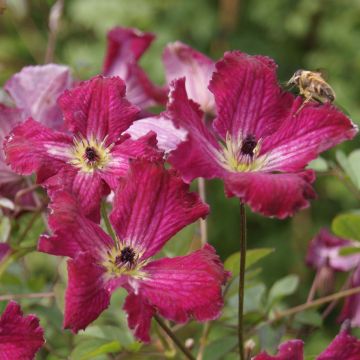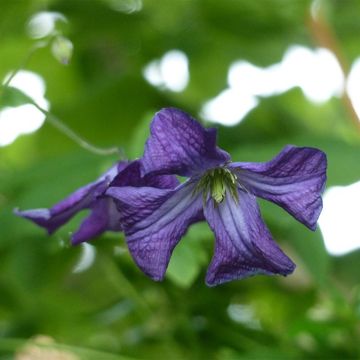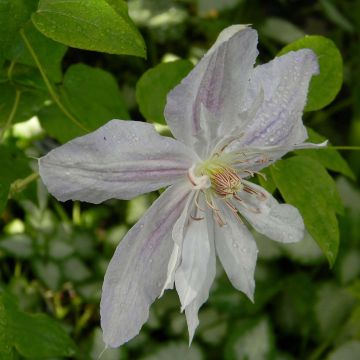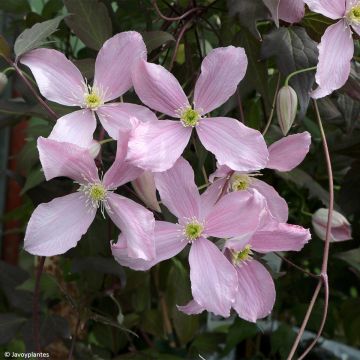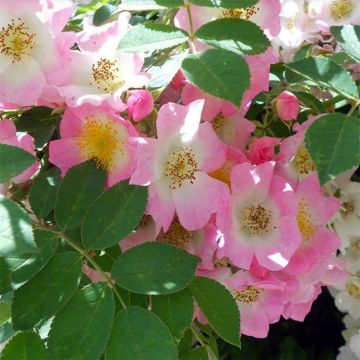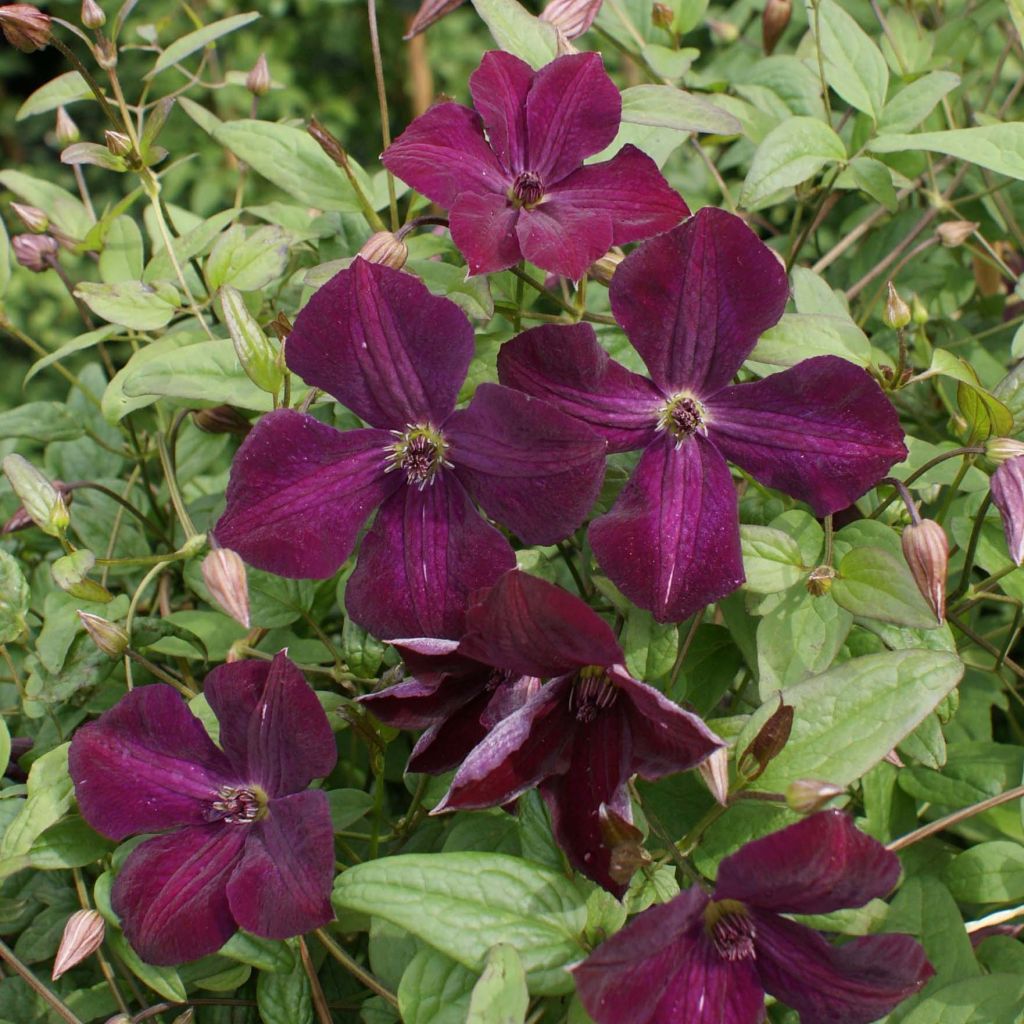

Clematis viticella Royal Velours


Clematis viticella Royal Velours


Clematis viticella Royal Velours
Clematis viticella Royal Velours
Clematis viticella Royal Velours
This item cannot be shipped to the selected country
Delivery charge from €5.90
More information
Schedule delivery date,
and select date in basket
This plant carries a 6 months recovery warranty
More information
We guarantee the quality of our plants for a full growing cycle, and will replace at our expense any plant that fails to recover under normal climatic and planting conditions.
From €5.90 for pickup delivery and €6.90 for home delivery
Express home delivery from €8.90.
Does this plant fit my garden?
Set up your Plantfit profile →
Description
Clematis viticella 'Royal Velours' has been a companion for generations of gardeners for over 100 years. This excellent French cultivar of C. viticella produces an abundance of single flowers throughout summer. They are medium-sized, with a rich and dark reddish-purple colour that is exceptionally velvety. It is a climbing vine-plant with vigorous, light, and graceful growth. It tolerates sunny exposures and dry soils quite well, and adorns even the humblest support with floral garlands. It is a reliable and robust variety, suitable for cultivation by beginners as well. Its dark flowers will look wonderful entwined in a bush with silver or grey foliage.
The genus Clematis belongs to the Ranunculaceae family. 'Royal Velours' is a horticultural variety obtained in Lyon in the 1900s by Francisque Morel. It is notably derived from Clematis viticella, the Italian clematis native to southern Europe, which is resistant to wilt disease. 'Royal Velours' belongs to the group of clematis that flower in summer on the current year's growth. It is a vigorous and climbing semi-woody perennial plant that will reach a height of 3 to 4m (10 to 13ft), with a spread of 2m² (7ft²). It has a rapid growth rate.
From June to September, this clematis bears medium-sized, fully open single flowers. The bisexual flowers are either solitary or grouped in cymes, upright or pendulous. They have 4 sepals of a deep red to crimson colour that becomes very dark, with a velvety texture. They are star-shaped with short purple stamens and yellow anthers. The flowering is followed by decorative greyish-silver feathery fruits. The small leaves are irregular and lobed, with irregularly serrated edges. They are olive-green and lighter on the underside.
Plant your clematis alongside climbing roses and climbers to extend the flowering period of walls and pergolas until the end of summer. This genus is rich in diversity, with varieties available in all colours, shapes, and sizes. Take advantage of their easy cultivation to give your garden a romantic and bohemian touch. 'Royal Velours' is very easy to grow in the garden. Its dark red flowers pair well with apricot-coloured roses ('Ghislaine de Feligonde', 'Alchymist', 'Crepuscule') and shrubs with grey foliage (Olearia 'Quick Silver', elaeagnus, Pyrus salicifolia).
Report an error about the product description
Clematis viticella Royal Velours in pictures
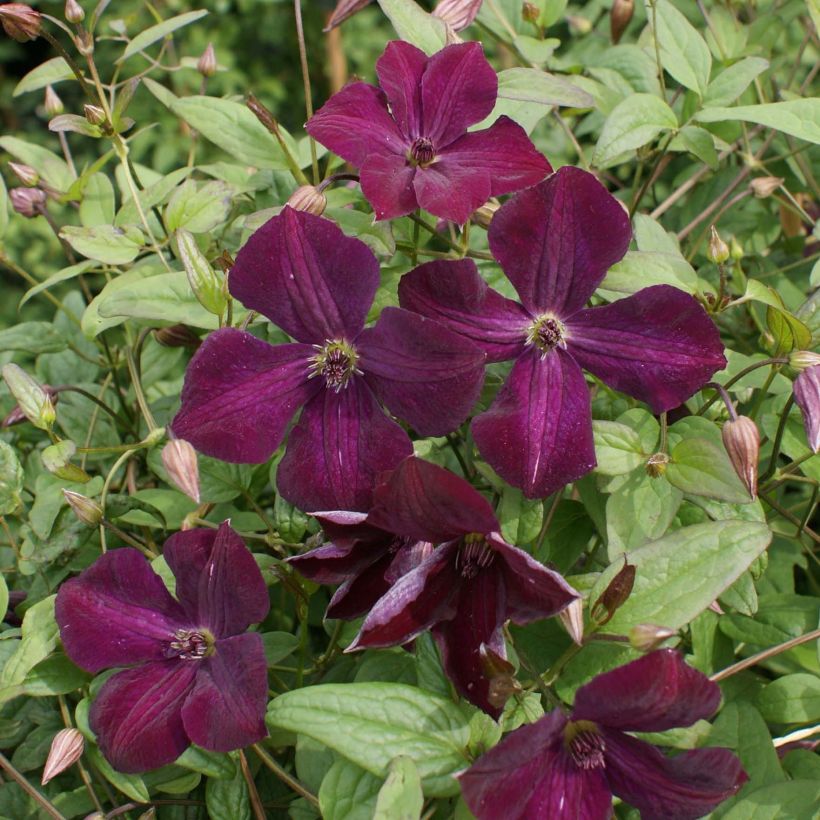





Plant habit
Flowering
Foliage
Botanical data
Clematis
viticella
Royal Velours
Ranunculaceae
Cultivar or hybrid
Other Clematis Viticella
Planting and care
Plant Clematis 'Royal Velours' in the sun, in fertile, humus-rich, well-drained soil. Shade the roots and base of the stem (with a flat tile, for example). Clematis from the C. viticella group are robust, undemanding in terms of soil, less capricious than large-flowered clematis, and less susceptible to wilt disease.
Work the soil to a depth of 20cm (8in), lightened with good quality compost. Plant it by covering the root ball with 3cm (1in) of soil. Water regularly and generously during the first few weeks. Do not overwater, as stagnant water can lead to the development of fungus at the base of the plant. Cover the base of climbing clematis with a small mound of soil to reduce the risk of wilting while promoting the growth of vigorous shoots from the stump. After planting, prune the stems of deciduous climbing clematis to about 30cm (12in) above a pair of buds.
Mulch in February with garden compost or well-rotted manure, avoiding direct contact with the stems.
Train the stems, without squeezing them, until the plant can cling by itself. Clematis also like to grow freely on neighbouring plants.
This variety blooms on new growth in summer, so prune it in March, leaving 25cm (10in) from the ground (a little less on older plants). Cut cleanly with secateurs above two large buds.
Voles and grey worms can attack clematis and devour the stems. Aphids and greenhouse whiteflies are also potential pests.
Planting period
Intended location
Care
-
, onOrder confirmed
Reply from on Promesse de fleurs
Foolproof climbers
Haven't found what you were looking for?
Hardiness is the lowest winter temperature a plant can endure without suffering serious damage or even dying. However, hardiness is affected by location (a sheltered area, such as a patio), protection (winter cover) and soil type (hardiness is improved by well-drained soil).

Photo Sharing Terms & Conditions
In order to encourage gardeners to interact and share their experiences, Promesse de fleurs offers various media enabling content to be uploaded onto its Site - in particular via the ‘Photo sharing’ module.
The User agrees to refrain from:
- Posting any content that is illegal, prejudicial, insulting, racist, inciteful to hatred, revisionist, contrary to public decency, that infringes on privacy or on the privacy rights of third parties, in particular the publicity rights of persons and goods, intellectual property rights, or the right to privacy.
- Submitting content on behalf of a third party;
- Impersonate the identity of a third party and/or publish any personal information about a third party;
In general, the User undertakes to refrain from any unethical behaviour.
All Content (in particular text, comments, files, images, photos, videos, creative works, etc.), which may be subject to property or intellectual property rights, image or other private rights, shall remain the property of the User, subject to the limited rights granted by the terms of the licence granted by Promesse de fleurs as stated below. Users are at liberty to publish or not to publish such Content on the Site, notably via the ‘Photo Sharing’ facility, and accept that this Content shall be made public and freely accessible, notably on the Internet.
Users further acknowledge, undertake to have ,and guarantee that they hold all necessary rights and permissions to publish such material on the Site, in particular with regard to the legislation in force pertaining to any privacy, property, intellectual property, image, or contractual rights, or rights of any other nature. By publishing such Content on the Site, Users acknowledge accepting full liability as publishers of the Content within the meaning of the law, and grant Promesse de fleurs, free of charge, an inclusive, worldwide licence for the said Content for the entire duration of its publication, including all reproduction, representation, up/downloading, displaying, performing, transmission, and storage rights.
Users also grant permission for their name to be linked to the Content and accept that this link may not always be made available.
By engaging in posting material, Users consent to their Content becoming automatically accessible on the Internet, in particular on other sites and/or blogs and/or web pages of the Promesse de fleurs site, including in particular social pages and the Promesse de fleurs catalogue.
Users may secure the removal of entrusted content free of charge by issuing a simple request via our contact form.
The flowering period indicated on our website applies to countries and regions located in USDA zone 8 (France, the United Kingdom, Ireland, the Netherlands, etc.)
It will vary according to where you live:
- In zones 9 to 10 (Italy, Spain, Greece, etc.), flowering will occur about 2 to 4 weeks earlier.
- In zones 6 to 7 (Germany, Poland, Slovenia, and lower mountainous regions), flowering will be delayed by 2 to 3 weeks.
- In zone 5 (Central Europe, Scandinavia), blooming will be delayed by 3 to 5 weeks.
In temperate climates, pruning of spring-flowering shrubs (forsythia, spireas, etc.) should be done just after flowering.
Pruning of summer-flowering shrubs (Indian Lilac, Perovskia, etc.) can be done in winter or spring.
In cold regions as well as with frost-sensitive plants, avoid pruning too early when severe frosts may still occur.
The planting period indicated on our website applies to countries and regions located in USDA zone 8 (France, United Kingdom, Ireland, Netherlands).
It will vary according to where you live:
- In Mediterranean zones (Marseille, Madrid, Milan, etc.), autumn and winter are the best planting periods.
- In continental zones (Strasbourg, Munich, Vienna, etc.), delay planting by 2 to 3 weeks in spring and bring it forward by 2 to 4 weeks in autumn.
- In mountainous regions (the Alps, Pyrenees, Carpathians, etc.), it is best to plant in late spring (May-June) or late summer (August-September).
The harvesting period indicated on our website applies to countries and regions in USDA zone 8 (France, England, Ireland, the Netherlands).
In colder areas (Scandinavia, Poland, Austria...) fruit and vegetable harvests are likely to be delayed by 3-4 weeks.
In warmer areas (Italy, Spain, Greece, etc.), harvesting will probably take place earlier, depending on weather conditions.
The sowing periods indicated on our website apply to countries and regions within USDA Zone 8 (France, UK, Ireland, Netherlands).
In colder areas (Scandinavia, Poland, Austria...), delay any outdoor sowing by 3-4 weeks, or sow under glass.
In warmer climes (Italy, Spain, Greece, etc.), bring outdoor sowing forward by a few weeks.




































